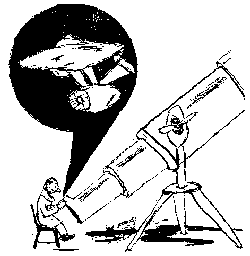Choosing a telescope
Article by Kevin Strider
This issue philosopher- writer, Kevin Strider, turns his attention to the budding astronomer and reveals there's a lot more to buying a telescope than meets the eye...... |
Thinking of buying a telescope? Well, there's a lot more to it than you might think. First of all you need to ask yourself exactly what you'll want out of it, this will give you some idea as to the size you should be aiming fro. Then there's the matter of how much you've got to spend, its size will be proportional to the size of your wallet.
To start off though, we need to get a few technical details out of the way:
Reflector or Refractor?
The first obvious difference between the two types is their size. The refractor will be a lot bigger generally, and will cost a lot more as well!
Refractors
These are ideal for planet spotting, searching for binary stars and nebulae. The diameter of the lenses starts at 2inches or 50mm. Shops normally sell them with a couple of eyepieces, offering different magnifications, and a map of the moon. You'll probably get a tripod too -- the quality depending on the price of the package. Prices start at £180.
Reflectors
This is the cheapest type of telescope, but there are a wide range of models and all have different price ranges. The types of reflectors commonly available are: NEWTONIAN, DOBSONIAN, & SCHMITT-CASSEGRAIN TELESCOPE (S.C.T.). A good Newtonian telescope starts at 6 inches (c. 150mm), and are quite cheap, prices starting at £400. However, Newtonians are hard to maintain, and you'll need to seek expert advice on areas such as collimation, dew and the type of tripod mount required.
Dobsonian telescopes are just as hard to look after. They look like lenses trapped inside a large cage. Some of them are quite cheap though (you can get a 6 incher from around £300). You'll need a dark area to use them though for, as they have an open tube, lightt passing through the sides can destroy the image you want to see. Park Hall Country Park (behind the old Willfield High School) is a good place to go. These telescopes usually come with their own mount, often a metallic or hardwood base, on which it can be rotated.
Reflectors gather more light than refractors because of their greater lens width, this makes them ideal for all types of astronomy, from watching the moon to searching for distant galaxies. However, NEVER POINT THEM AT THE SUN as the magnification would instantly burn out your retina and render you blind. (Just think how a simple magnifying glass can burn the skin, even in the dullest daylight.) The same applies for binoculars and refractors.
S.C.T.s are much smaller by comparison, but also quite expensive -- a 6 inch model will start at £1200. They are however light, portable, and usually come with an excellent tripod. They are much easier to look after than the other types and, in my opinion, the best type for 'light polluted' places like Stoke-on-Trent. Nowadays retailers sell the S.C.T. in a package deal that includes a tripod, a device for moving the telescope electronically, and a map.

Of course, the bigger your telescope, the more you'll see -Ed
If you are buying your first telescope, and are new to this fascinating field of science, then I would advise you to start with a smaller telescope (say, 4 inches). Don't expect to see the glorious images that you see in the glossy magazine photo-spreads, however you can expect to see many thousands of objects that you could never see with the unaided eye. Then, if you decide that astronomy is for you, and you wish to get serious, you can upgrade to a larger model later. Keep in mind the environment that you live in, especially the amount of artificial light at night.
Surprisingly enough, a simple pair of binoculars is often sufficient for the beginner. You'll need what are called 10x50s. The first number being the magnification they give you, and the second number is the diameter of the front lenses (in millimeters). When buying a pair of binoculars for astronomy, make sure that the diameter of the lenses is at least five times greater than the magnification. And remember our warning: never, ever point them at the sun. (EXTRA TIP: For those with hands as shaky as mine, you may need a tripod too, to see a clear image. -- Ed)
But whatever you buy, make sure that you spend some time talking to the shopkeeper, he will tel you exactly what you'll get from each telescope for the price you're prepared to pay, and, in my experience, will offer some kind of after sales service.
Generally, the deeper into the universe that you wish to see, the larger and more expensive the telescope you'll have to buy. Most amateurs telescopes are between 4 and 18 inches (10 and 40cm).
Above all though, the best part of astronomy is that beginners, amateurs and professionals alike can all offer something to the science. You never know, one day there may be a new supernova or comet named after you. Good magazine to read are ASTRONOMY (American) and ASTRONOMY NOW (British). Good viewing!
EXTRA, EXTRA TIP: Being as winter is the best season for
astronomy (longer nights), I think mention should be made
of thermal underwear, and the thermos flask. -- Ed.
Copyright The Bentilean 1999
Back to: The Contents Page | The Archive | The Bentilean Main Page